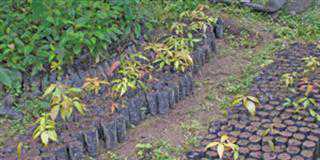
Photo: FW Archive
Food is a delicate commodity. About one-third (1,3 billion tons) of that produced around the world for human consumption is lost or wasted every year.
Post-harvest loss (PHL) can be described as the fruit and vegetables produced that do not reach consumers due to degradation in quality and quantity. Effectively, it includes the loss of the food itself and the inputs required to produce and distribute it. It is a loss that has long concerned both farmers and sellers.
The world’s population is expected to reach 9,7 billion by 2050, and this will require an increase in global food production of about 60% from current levels, as well as more equitable access to food. As it stands, over 815 million people around the world are chronically undernourished, especially in parts of sub-Saharan Africa and South Asia, where 22,8% and 14,7% of people respectively are undernourished.
The greatest PHLs reported in the fresh produce sector are of fruit, root vegetables and tubers. Regional data for fruit and vegetable losses show that all regions across the globe lose at least 20% of their fresh produce, with extreme losses of 45% and 50% recorded in Africa and Asia respectively.
These figures align with those seen in Limpopo, where 50% of the mango, banana, orange and pawpaw crops produced by smallholder farmers and sold by street vendors are lost. In KwaZulu-Natal, 76,6% of the tomatoes grown are lost after harvesting.
PHL in developing countries such as South Africa are the result of poor post-harvest food handling and storage, and a lack of appropriate technology.
Reducing the losses
Because of the scale of PHL worldwide, reducing it will help to create more sustainable and resilient food systems and lower greenhouse gas emissions. At the same time, it will assist in optimising agricultural productivity and increase the incomes of small-scale food producers and the associated value chain players, especially women, who are traditionally responsible for many post-harvest activities.
The volume of food wasted has led to an increase in global studies aimed at quantifying the actual amount, as well as analysing and understanding its drivers. A sound knowledge of food waste is critical for informing efforts to meet the UN’s Sustainable Development Goals, particularly Target 12,3 of Goal 12, which is to halve global per capita food waste by 2030.
Causes of post-harvest loss
The causes of PHL and the stages at which it occurs are numerous; they also vary according to the type of crops produced, the production processes, the climate in the specific region, and market demand.
Damage or loss can occur at every post-harvest stage. For example, part of the crop may be left unharvested on the land, spilled during transportation, or attacked by pests or microbes during storage.
Approximately 48% of smallholder farmers experience losses due to bad weather, such as excessive heat, hailstorms and drought. Incorrect harvest and post-harvest practices also result in losses due to spoiling of the product before it reaches the market, as well as a deterioration in appearance, taste and nutritional value.
In developing countries, most handlers involved in harvesting, packaging, transporting and marketing the produce have limited or no appreciation for the need to maintain quality, and lack the knowledge of how to do so.
The time of picking or harvesting is considered the most important factor in the PHL of fresh produce. Fruit and vegetables are at their heaviest and firmest in the morning, when the temperature is cool and the humidity high. Warmer temperatures and evaporation are the main factors that cause the produce to shrink, making them unsuitable for markets.
The most important goals of post-harvest handling are to keep the product cool and at a high relative humidity during storage and transport, thereby preventing moisture loss and physical damage such as bruising. The low temperature decreases physiological, biochemical and microbiological activity, which cause quality deterioration.
The high relative humidity decreases the loss of water from the produce, reducing weight loss.
In most cases, smallholder farmers are unable to invest in proper cold storage facilities. They are therefore forced to store the produce in their houses to at least keep it out of the sun.
They also lack refrigerated vehicles for transporting and delivering their produce. This break in the cold chain leads to the rapid deterioration of the fruit and vegetables, which can result in markets and retailers rejecting the produce.
Beauty sells
Since consumers tend to ‘buy with their eyes’, the most attractive fruit and vegetables on the market therefore tend to sell at the highest price, while those that are less appealing sell at lower prices and, in many cases, are simply discarded.
The size, shape and colour of fresh produce are important factors when sending it to the market. Smallholder farmers have reported 9% wastage as a result of their produce being rejected at markets and returned to them for failing to meet these quality standards.
Depending on the farmer, the rejected produce is then used for composting or as animal feed. If it is still fit for human consumption, it may be donated to charities.
The other option is to give the go-ahead for the produce to be thrown away at the market.
All of these outcomes obviously mean that the farmer earns no income from the produce.
Co-ops and collective action
Smallholder producers often market their produce collectively in order to reduce
compliance and transaction costs. However, these groups have their own costs and institutional difficulties, which hamper smallholder farmer participation.
There is therefore a need for the formation and strengthening of producer associations that jointly market and process outputs, thereby reducing transaction costs and increasing negotiating power.
Collective action also enables individual smallholder farmers to attain economies of scale in terms of the supply and scope of produce.
Summarised, the reasons for setting up co-operatives and collective action groups include:
- The high transaction costs of the market;
- Promoting self-help and -sustainability;
- Enhancing bargaining strength with input suppliers and fresh fruit buyers;
- Gaining an opportunity to operate at cost;
- Boosting members’ incomes;
- A greater assurance of input supplies and product markets, particularly for perishable crops such as fruit and vegetables;
- Coordinating the flow of input supplies to farms and farm products to markets;
- Reducing the chance of opportunistic behaviour of potential competitors;
- Benefitting from economies of scale when using marketing services; and
Promoting community development in general.
Training and tools
Many of these objectives are achievable through proper training, the adoption of appropriate tools and/ or technologies, effective handling practices and sound policies.
Extension personnel in particular should encourage the correct use of techniques and equipment for better post-harvest management.
Importantly, both smallholder farmers and farmworkers require training in post-harvest handling and storage. This should include education in food hygiene and how to ensure that these standards are adhered to.
All of this is essential for sustainable agricultural development and long-term food security.
In addition to ensuring that the information provided during a training programme is up to date and relevant, organisers should take care when deciding on where it will take place, its duration, and the languages that will be used, so that trainees have the best chance of understanding the content.
Trainers should bear in mind, too, that knowledge is more effectively understood and retained if active learning, such as hands-on or role-playing activities, is incorporated.
Email Manoshi Mothapo at [email protected].













